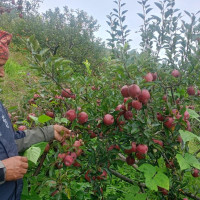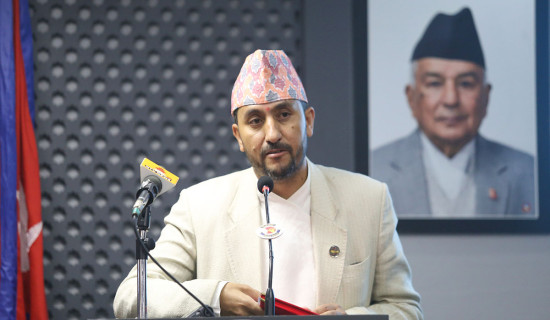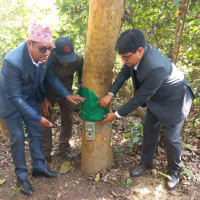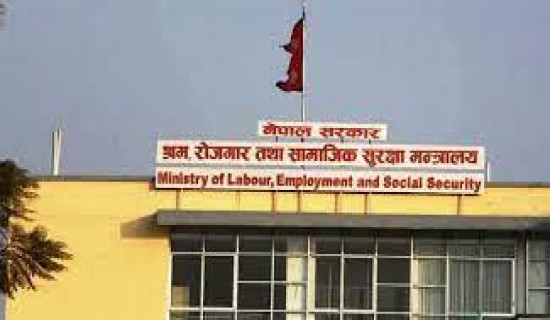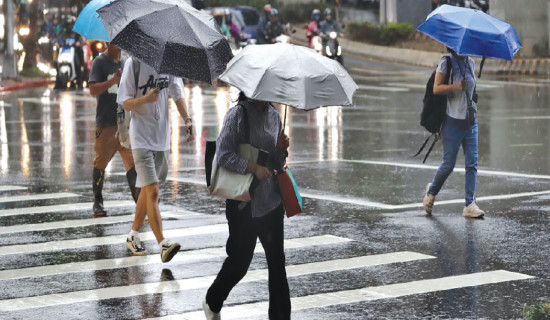- Tuesday, 16 December 2025
Kathmandu air very unhealthy, eye irritation complained
Kathmandu, Apr. 4: For the fourth consecutive day, Kathmandu remained the most polluted city in the world. On Thursday afternoon, the city's overall Air Quality Index (AQI) reached around 300, a level considered very unhealthy. The AQI in Rabi Bhaban reached 600 on the same day, indicating hazardous level.
Many people reported experiencing eye irritation, throat discomfort and sneezing. Experts attributed the alarming situation to pre-monsoon forest fires across the country, especially in the west where many districts are in moderate to extreme drought.
Fire expert Sundar Sharma attributed the hazardous pollution levels to widespread forest fires. Within 24 hours, 350 forest fire incidents were reported across 47 districts, with the most affected areas being Parsa, Chitwan, Bara, Kanchanpur, Nawalparasi-East, Makawanpur and Rautahat.
On Thursday, the AQ Monitoring Dashboard recorded alarming AQI levels -- 365 in Bhaktapur, 273 in Shankhapark, 248 in Ratnapark and 235 in both Bhaisipati and Khumaltar. An AQI between 300 and 400 is considered hazardous.
Within a week of rising pollution levels, the Outpatient Department at TU Teaching Hospital recorded at least a 15 per cent increase in patients visiting the Pulmonology and Critical Care Unit.
According to Dr. Niraj Bam, head of the department, cases of viral infections, cough, cold and complications in patients with chronic illnesses have increased. “The rise in patients can be attributed to worsening air pollution in the Valley. This problem occurs every year unless the government enforces policies to control pollution in the long run,” he said.
Dr. Bam advised people to take precautions, follow health protocols and wear masks to minimise exposure. Amid growing concerns, people are eagerly waiting for rainfall to reduce pollution by dousing the forest fires spreading across the country. However, the Meteorological Forecasting Division has said that there is no hope for rain or strong winds to clear the haze covering the Valley’s skies.
Pratibha Tuladhar, a senior meteorologist at the Forecasting Division under the Department of Hydrology and Meteorology, said there is no chance of rainfall or strong winds for the next three days. She explained that a high-pressure system has stalled over the Indian subcontinent, keeping the weather stagnant. As a result, the system is preventing any improvement in air quality and blocking the conditions needed for rainfall. At the same time, the western low-pressure system has not been activated and local winds remain inactive.
Due to the lack of rainfall, pollution levels have been rising every day. The bowl-shaped Kathmandu Valley traps pollution, preventing it from dispersing until strong winds or rain clear the air. Visibility has also dropped significantly in the morning.
“The wind speed was measured at 11 knots in the afternoon, up from 8 or 9 knots in the morning, but this is not enough to clear the pollution. For significant improvement, the wind speed needs to reach 20 to 30 knots,” Tuladhar said.
Environmental expert Bhusan Tuladhar said that pollution levels have increased not only in the Kathmandu Valley but also in other cities, mainly due to forest fires and the burning of agricultural waste. “The Valley has always struggled with pollution, but this time, the dry weather and forest fires have sharply worsened air quality, reaching unhealthy to hazardous levels, which are extremely harmful to public health,” he said.
Forest fires are now raging in 200 to 300 locations daily and have become uncontrollable in many areas. However, fires in unaffected areas can still be prevented through awareness campaigns, collecting dried leaves--which serve as primary fuel in forests, and quickly containing fires when they break out, he said. To reduce pollution in the long run, Tuladhar stressed the need for an Air Quality Management Plan to be formulated. The Ministry of Forests and Environment decided to formulate the plan three months ago, but it now needs to be moved forward.
There is a lot that can be done, he said. “For example, Nepal Rastra Bank previously instructed to provided 80 per cent loan for electric vehicles (EVs), but this has now been reduced to 60 per cent, discouraging potential EV users. The government should introduce subsidies for EVs since the initial investment is high. Other countries have implemented similar policies, often funding them through pollution taxes on petrol and diesel vehicles,” he said. Tuladhar also pointed out that Nepal’s Second Nationally Determined Contribution (NDC) Implementation Plan has provision to allocate 25 per cent of tax revenue from fossil-fuel vehicles to public EV initiatives.
ICIMOD also issued a press release on Thursday to address this alarming situation. Sagar Adhikari, Air Pollution Analyst, ICIMOD, said in the statement “The prevailing dry conditions have led to more instances of forest fires across the country. In addition to the existing pollution being emitted from different sectors i.e. residential, transport and dust, forest fires have worsened these conditions. Existing meteorological conditions are also leading to pollution stagnating over the valley."
Notable emissions coming from forest fires include carbon monoxide, fine particulate matter in the form of PM2.5 and black carbon. When breathed in, these fine particles can enter the bloodstream and lead to respiratory conditions, and even death, he added.
Narayan Babu Dhital, Assistant Professor at Patan Multiple Campus, Tribhuvan University, said, “While estimates of mortality and morbidity rates from forest fires do not yet exist, this does show the urgency for investing in primary baseline data. Our research shows that ambient PM2.5 air pollution has contributed to 48,000 deaths in 2019. We used secondary data including the Global Burden of Diseases data source to carry out our analysis.”





